By Sue Williams
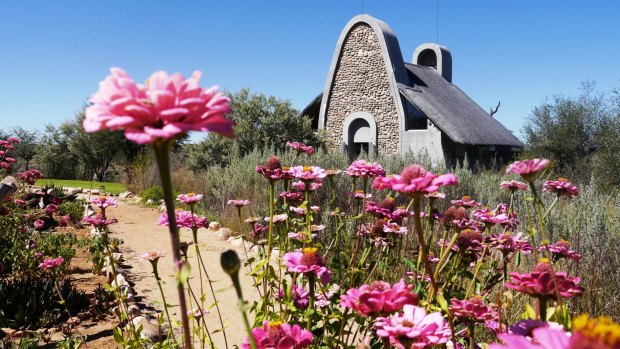
Naankuse Lodge.
The advance briefing about the dangers that lie ahead is chilling.
Take off all jewellery – particularly earrings that can be savagely ripped off – as well as hats that might be shredded and sunglasses that will be smashed. Also be careful neither to shriek in terror nor to smile in false bravado as either could be misinterpreted as a threat – with unfathomable consequences.
Finally, we set off on our march through the wilds of the southern African country of Namibia, with our guide Johannes ahead. Sure enough, it's only a minute before we hear the thunder of footsteps from behind, racing to catch up with us.
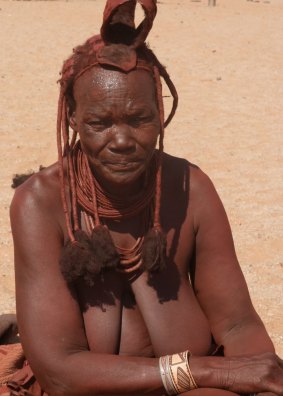
Himba.Credit: Sue Williams
Seconds later, I feel the sudden impact of something leaping at me, whacking me hard in the back and then holding on tight. Another moment, and I'm attacked from the side and the front. The breath's been knocked out of me, and I can barely shuffle forward with the weight of all my hangers-on.
Going for a walk with a bunch of boisterous young baboons is a serious business in Namibia.
But Ash, Sheela and Bella seem to be enjoying it immensely as they swing on me, examining my ears and hair for any tasty fleas, while tiny baby Frodo tries to climb inside my T-shirt. The best mantra for visitors to Namibia, the massive country bordering South Africa to the south, Botswana to the east and Angola and Zambia to its north, seems to be: expect the unexpected.
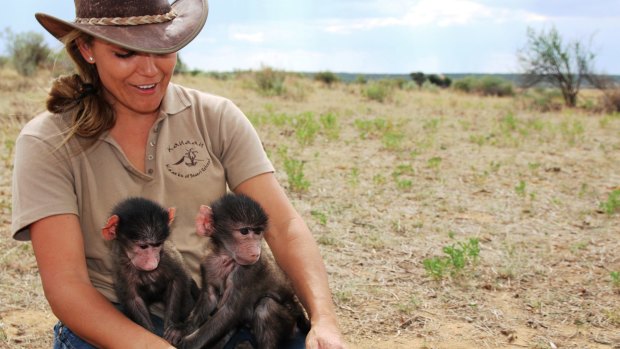
Marlice and baboon babies.
In truth, I hadn't quite known what this nation, one of the last great unknowns in Africa, would be like. In stark contrast to some other parts of Africa, it's extremely stable, there's no ebola threat and tourism is an emerging industry. Beyond that, it was pretty much a mystery.
But a day after my arrival, via Perth to Johannesburg in South Africa, and then the short hop to the Namibian capital Windhoek, I was starting to feel very relaxed. Until all the warnings about the baboons on my first stop, at the award winning N/a'an ku sê Foundation, set up to rescue animal species – and traditional tribal people – under threat.
After a few minutes of getting used to animals jumping on me, it proved enormous fun. The young baboons have been rescued after being orphaned or injured in the wild, and are allowed to run free in certain areas of the project's 3,200 hectare wildlife sanctuary. When they grow big enough, they'll be released back into the wild.
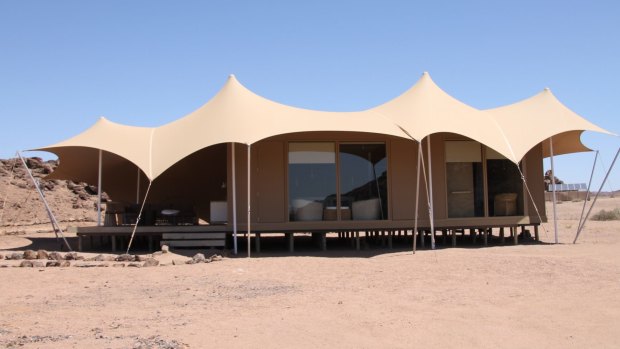
The accommodation.Credit: Sue Williams
Going for a walk with them is one of the real attractions for visitors, playing with them as you meander along paths through the camel thorn trees and riverbeds of the property.
But they're not the only stars. Kiki the cheetah is the companion on another walk, while a group of San Bushmen, among the world's oldest surviving hunter-gatherers, demonstrate their ancient bushcrafts on another outing. As well as collecting food and medicine along the way, they show visitors which trees they make their spears and arrows from – and which leaves to chew to extract the deadly poison they use for the tips.
Namibia is a huge country, well over twice the size of Germany, with the oldest desert in the world, the Namib, stretching down its Atlantic coast, and the semi-arid Kalahari Desert running vertically along its eastern boundary. In the middle is the wide Central Plateau where most of its population lives. It's the second least densely populated country in the world after Mongolia.
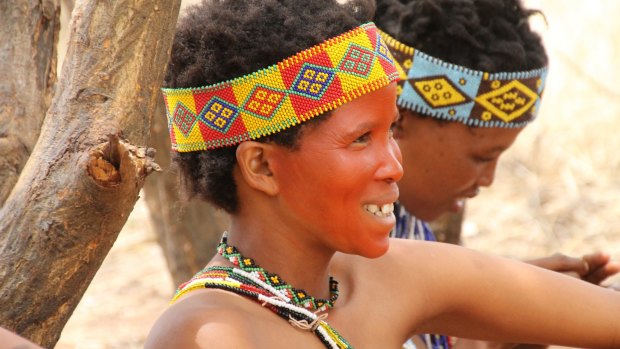
San bushmen.Credit: Sue Williams
That makes Namibia pretty wild, open and unspoilt, the ultimate get-away-from-it-all destination, the perfect place for a digital detox away from the rest of the world. It has stunning desert landscapes, lots of game roaming free and some of the most amazing ecologically-friendly yet luxurious accommodation in Africa.
At N/a'an ku sê, for instance, my chalet has a floor of compressed mud, tree stumps for bedside tables and seats, a straw roof and log beams, but also a gorgeous step-down bath and shower, sliding glass doors to a private terrace overlooking the vast horizon, and glass higher up to view the stars at night.
While some visitors choose to drive between attractions, the country's also set up with a network of small planes giving you a bird's eye view over the land as you travel. So after N/a'an ku sê, I'm back to the airport for the one-hour plane ride to Sossusvlei, the site of some of the world's highest sand dunes.
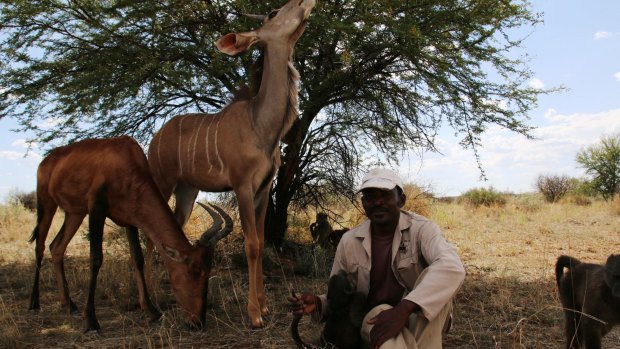
Johannes, Kangoni and Merlot.Credit: Sue Williams
The sight of these vast swirls of fiery red sand is astonishing. The climb along the ridges to look down at the flat salt plains far below, and then scooting down the almost sheer faces, is exhilarating.
Here, I stay at Little Kulala, an elegant lodge amidst the oceans of sand, with its own wine cellar and library, and a series of thatched villas each with a deck and plunge pool and an extra bed on the rooftop if you feel like sleeping under the stars.
A couple of days later, I fly north, over Namibia's highest mountain Brandberg, to Damaraland, among dramatic black hulking Etendeka mountains and red sandstone cliffs. It's great walking country, as well as the perfect place for wilderness drives to spot game, and view prehistoric rock art.
The Doro Nawas Camp resembles a medieval castle sitting on a hilltop, like something out of Game of Thrones, but it's circled by an outside dining terrace with wonderful views over the sun-baked dry river valley. Its villas have a wonderful twist: on request, staff will wheel your bed onto the terrace so you can sleep outside. The only problem is the stars are so bright – and sometimes you can hear animals howling so close – it can be difficult to sleep.
From there, it's another flight to the Hoanib Skeleton Coast further north, a vast, isolated wilderness of white sand and cracked riverbeds. The camp here, accessible only by plane, is new, its lodge a stylish modern structure and its villas boast shady decks.
A flight west to the misty coastline reveals shipwreck remains, seal colonies and flamingos. There is a break for lunch on a white-clothed table set up on the water's edge.
After two days, the next flight is another hour further north, and then there is an hour's drive winding across towering mountain passes into completely different terrain, on the Kunene River that forms the border with Angola. A boat ride along the river feels like another world, with the first lush greenery I've seen in Namibia, and villagers and animals appearing and disappearing along the banks.
The camp, Serra Cafema, offers another luxurious set of villas with tented walls and decorated like an old safari camp with leather suitcases, brass lamps and fittings, flowing curtains and indoor and outdoor bathrooms.
Beyond the camp is the area's real point of interest. Over sand dunes and across mountain ravines is the camp of the indigenous Himba tribe.
A collection of cow-dung huts on a swathe of sand in the middle of nowhere in one of the most remote spots in the world, it's breathtaking to see people still living as they have for centuries. The women, with their hair encased in ochre clay, sell traditional handicrafts to visitors and sit and 'chat' in mime language.
I only have one more destination in Namibia, and that proves yet another shock. This time, I fly to Etosha, in the national park, the main tourist hub of the country. After eight nights of feeling as if I were in some remote parallel universe full of sand and dry creek beds and ghostly animals, far from the rest of the world, I'm suddenly back among tourists and real game lodges.
With the Ongava Tented Camp as my base, it is miraculous to see so many animals in a single place, to chat to others travelling around the country and to swim in the camp's pool watching a constant parade of wildlife similarly enjoying water close by.
Once again, I realise it's all about expecting the unexpected. With so much of the rest of Africa undergoing rapid change, Namibia feels like it's been quarantined from much of that by its inaccessibility, its deserts, its harsh climate and its lack of population.
Of course, who knows how long it will stay like that. I feel lucky to have seen it as it is.
TRIP NOTES
MORE INFORMATION
GETTING THERE
Fly to Namibia with South African Airways (www.flysaa.com/au) from Perth to Johannesburg, and then connect to Windhoek.
STAYING THERE
The lodges the company recommends – all luxury "tented" accommodation where it's a shock to discover the walls of the freestanding suites are actually canvas – include N/a'an ku sê, just outside Windhoek, Little Kulala at Sossusvlei, Doro Nawas Camp at Damaraland, Hoanib Skeleton Coast at Palmwag, Serra Cafema Camp at Kunene and the Ongava Tented Camp at Etosha (see www.classicsafaricompany.com.au).
TOURING THERE
The Classic Safari Company has a range of itineraries to suit different interests and budgets (www.classicsafaricompany.com.au). Ph 02 9327 0666.
Sue Williams was a guest of The Classic Safari Company and South African Airways.
Sign up for the Traveller Deals newsletter
Get exclusive travel deals delivered straight to your inbox. Sign up now.